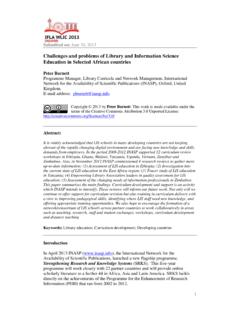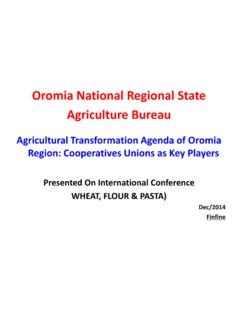Transcription of Nutrition and food systems - Food and Agriculture ...
1 12 HLPE REPORTHLPEHigh LevelPanel of ExpertsA report byThe High Level Panel of Expertson food Security and NutritionNutrition and food systemsSeptember 20172 HLPE Reports series #1 Price volatility and food security (2011) #2 Land tenure and international investments in Agriculture (2011) #3 food security and climate change (2012) #4 Social protection for food security (2012) #5 Biofuels and food security (2013) #6 investing in smallholder Agriculture for food security (2013) #7 Sustainable fisheries and aquaculture for food security and Nutrition (2014) #8 food losses and waste in the context of sustainable food systems (2014) #9 Water for food security and Nutrition (2015) #10 Sustainable agricultural development for food security and Nutrition : what roles for livestock? (2016) #11 Sustainable forestry for food security and Nutrition (2017) #12 Nutrition and food systems (2017) All HLPE reports are available at 3 HLPE Steering Committee members (September 2017) Patrick Caron (Chair) Carol Kalafatic (Vice-Chair) Amadou Allahoury Louise Fresco Eileen Kennedy Muhammad Azeem Khan Bernardo Kliksberg Fangquan Mei Sophia Murphy Mohammad Saeid Noori Naeini Michel Pimbert Juan ngel Rivera Dommarco Magdalena Sep lveda Martin Yemefack Rami Zurayk HLPE Project Team members Jessica Fanzo (Team Leader) Mandana Arabi Barbara Burlingame Lawrence Haddad Simon Kimenju Gregory Miller Fengying Nie Elisabetta Recine Llu s Serra-Majem Dipa Sinha Coordinator of the HLPE Nathana l Pingault This report by the High Level Panel of Experts on food Security and Nutrition (HLPE) has been approved by the HLPE Steering Committee.
2 The views expressed do not necessarily reflect the official views of the Committee on World food Security, of its members, participants, or of the Secretariat. The mention of specific companies or products of manufacturers, whether or not these have been patented, does not imply that these have been endorsed or recommended by the HLPE in preference to others of a similar nature that are not mentioned. This report is made publicly available and its reproduction and dissemination is encouraged. Non-commercial uses will be authorized free of charge, upon request. Reproduction for resale or other commercial purposes, including educational purposes, may incur fees. Applications for permission to reproduce or disseminate this report should be addressed by e-mail to with copy to Referencing this report: HLPE. 2017. Nutrition and food systems . A report by the High Level Panel of Experts on food Security and Nutrition of the Committee on World food Security, Rome.
3 4 Contents Foreword .. 9 Summary and Recommendations .. 11 Summary .. 11 Recommendations .. 17 Introduction .. 21 1 Setting the stage: approach and conceptual framework .. 23 Definitions and overview of the conceptual framework .. 23 The constituent elements of food systems .. 24 food supply chains .. 24 food environments .. 28 Consumer 31 Diets .. 32 Healthy and sustainable diets .. 32 The Nutrition , health, environmental, economic and social outcomes of diets .. 34 A food system typology .. 35 Traditional food systems .. 38 Mixed food systems .. 39 Modern food 40 Conclusion .. 41 2 The multiple burdens of malnutrition .. 43 The current burdens of malnutrition .. 43 Malnutrition: situation and trends .. 44 Malnutrition: regional patterns .. 46 Vulnerability to malnutrition .. 48 The consequences of malnutrition .. 50 Health consequences .. 50 Economic and social consequences .. 52 Nutrition outcomes across food system types.
4 53 Conclusion .. 54 3 Diets in transition .. 55 Changing diets .. 55 Current food consumption trends and dietary patterns .. 55 Shifts in dietary patterns: the Nutrition transition .. 58 Projected future dietary trends and sustainability .. 60 Diets of vulnerable groups .. 61 Territorial influence of diets .. 64 5 The role of income on diets .. 65 Conclusion .. 66 4 Drivers of food system changes .. 67 Biophysical and environmental drivers .. 67 Natural resources and ecosystem services .. 67 Climate change .. 69 Innovation, technology and infrastructure drivers .. 70 Innovation and technology .. 70 Infrastructure .. 71 Political and economic drivers .. 72 Leadership .. 72 Globalization and trade .. 72 food , Agriculture and Nutrition policies .. 73 food prices and volatility .. 75 Land tenure .. 75 Conflicts and humanitarian crises .. 76 Socio-cultural drivers .. 78 Cultures, rituals and social traditions.
5 78 Women s empowerment .. 79 Demographic drivers .. 80 Population growth and changing age distribution .. 80 Urbanization .. 80 Migration and forced displacement .. 81 Conclusion .. 81 5 Positive directions for food systems , diets and Nutrition .. 83 Priorities for action in food supply chains .. 83 Production systems .. 83 Storage and distribution .. 88 Processing and packaging .. 89 Retail and markets .. 91 Evidence gaps in the food supply chain .. 92 Key points of interventions across food supply chains .. 93 Priorities for action in food environments .. 94 Physical access (proximity) .. 94 Economic access (affordability) .. 95 Promotion, advertising and information .. 97 food quality and safety .. 99 Evidence gaps for the food environment .. 100 Key points of interventions across food environments .. 100 Priorities for orienting consumer behaviour towards healthier diets .. 102 Nutrition education.
6 102 food acceptability .. 104 Social norms and traditions .. 105 6 Evidence gaps in consumer behaviour .. 106 Key points of interventions to orient consumer behaviour .. 106 Investment and intervention priorities across food system types .. 108 Traditional food systems .. 109 Mixed food systems .. 109 Modern food 109 Conclusion .. 109 6 Translating evidence into action .. 111 Motivations for action .. 111 Barriers and obstacles that prevent action .. 112 Failure to recognize the right to adequate food .. 112 Power imbalances across food 112 Conflicts of interest .. 113 Enabling conditions to improve Nutrition and food systems .. 114 Build a supportive political environment .. 114 Invest in Nutrition and food systems .. 116 Develop human capacity across Nutrition and food 116 Support movements, coalitions and networks .. 117 Develop new partnerships .. 118 Conclusions and key messages .. 118 Conclusion.
7 119 Acknowledgements .. 120 References .. 121 Appendix .. 150 The HLPE project cycle .. 150 7 List of Figures Figure 1 Conceptual framework of food systems for diets and Nutrition .. 26 Figure 2 Proportion of household budgets spent on food in different countries (2015) .. 30 Figure 3 food supply chains and food environments .. 36 Figure 4 Common indicators for assessing childhood malnutrition .. 44 Figure 5 Numbers (millions) of stunted and overweight children under five years of age in Africa, Asia, Oceania, Latin America and the Caribbean, and North America .. 45 Figure 6 The burden of undernutrition through the life cycle and across generations .. 49 Figure 7 Prevalence of health and Nutrition outcomes across different food system types .. 53 Figure 8 Intake of key foods and diet components, by region, 2013 .. 56 Figure 9 Changes in intake of key foods and diet components by region, 1990 2013 (percent) .. 57 Figure 10 The Nutrition transition.
8 59 Figure 11 Consumption of foods and other diet components by national income group, 2013 .. 66 Figure 12 Map showing (in dark) countries with a food based dietary guideline (FBDG) .. 73 Figure 13 The impact of conflict on reductions in undernutrition .. 77 Figure 14 Exit and entry points along the Nutrition value chain .. 93 Figure 15 Improved food systems for better diets and Nutrition .. 107 Figure 16 Prioritized investment across food system types .. 108 Figure 17 HLPE project cycle .. 151 List of Definitions Definition 1 food environment .. 28 Definition 2 Sustainable diets .. 34 List of Tables Table 1 Classification by degree of processing of food and beverage products .. 27 Table 2 Typology of food value chains .. 36 Table 3 food system types and their food supply chains and food 37 Table 4 Prevalence of vitamin A deficiency (2005), iodine deficiency (2013), inadequate zinc intake (2005) and iron deficiency anaemia (2011) .. 46 Table 5 Summary of evidence on taxes and subsidies.
9 96 Table 6 Summary of key points for intervening in different food systems to improve food environments .. 101 List of Boxes Box 1 A traditional food environment in rural Kenya .. 38 Box 2 The rise of street food in mixed food systems .. 39 Box 3 The transitioning Indian urban food 40 Box 4 Measuring malnutrition: some commonly used indicators .. 43 Box 5 Tackling obesity in middle- and high-income countries: no silver bullets .. 47 Box 6 Maharashtra, India, as a case study for significant reductions in stunting .. 50 Box 7 food fortification (wheat flour, maize flour, milk) with iron in Costa Rica .. 51 Box 8 Tackling micronutrient deficiencies through dietary diversity approaches .. 52 Box 9 International Code of Marketing of Breast-milk Substitutes .. 62 Box 10 Complementary feeding 62 Box 11 The Mediterranean diet: a model of a sustainable diet .. 64 8 Box 12 Global and regional health effects of future food production under climate change.
10 70 Box 13 Impact of food subsidies on Nutrition outcomes: the cases of the United States of America and Egypt .. 74 Box 14 Globally Important Agricultural Heritage systems in China .. 85 Box 15 Farm-to-school programmes in the Caribbean .. 86 Box 16 Let s Go Local: promoting nutritious biodiversity in the Federated States of Micronesia .. 88 Box 17 Post-harvest interventions to reduce aflatoxins in Guinea .. 89 Box 18 A partnership among government, non-governmental organizations and producer cooperatives to improve iodized salt coverage in ethiopia .. 90 Box 19 Increasing the availability of fruits and vegetables in low-income neighbourhoods of New York .. 94 Box 20 The use of trade-related policy to reduce fatty meat availability in Samoa and Fiji .. 95 Box 21 Taxation of sugar-sweetened beverages and non-essential energy-dense foods in Mexico .. 96 Box 22 Regulation of marketing, labelling and the school environment in Chile: a comprehensive policy to tackle obesity and improve the food system .












